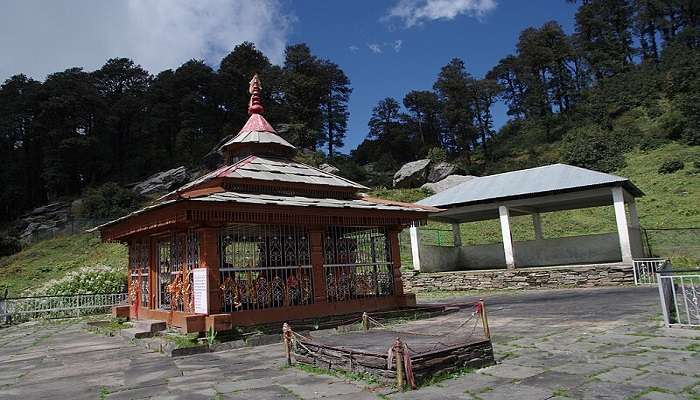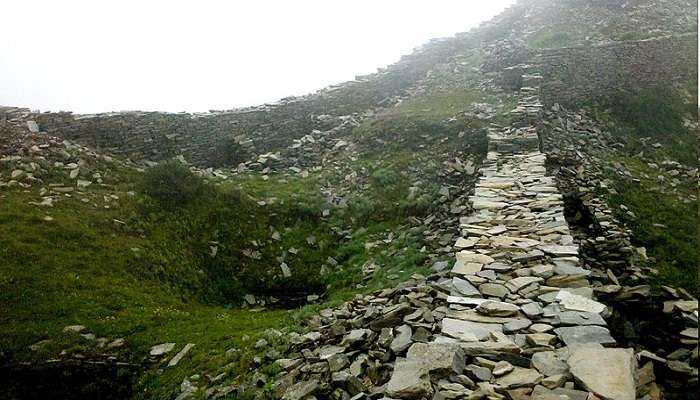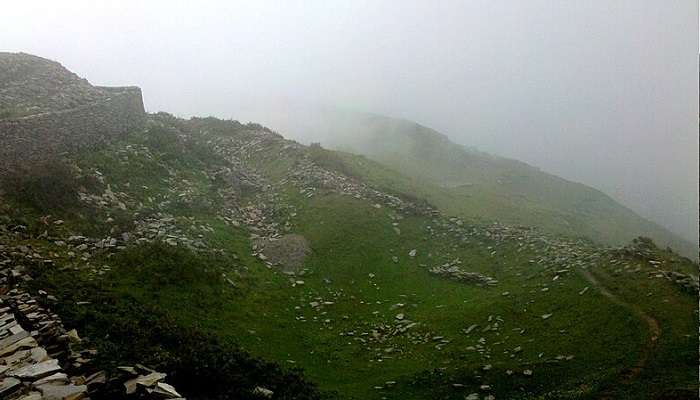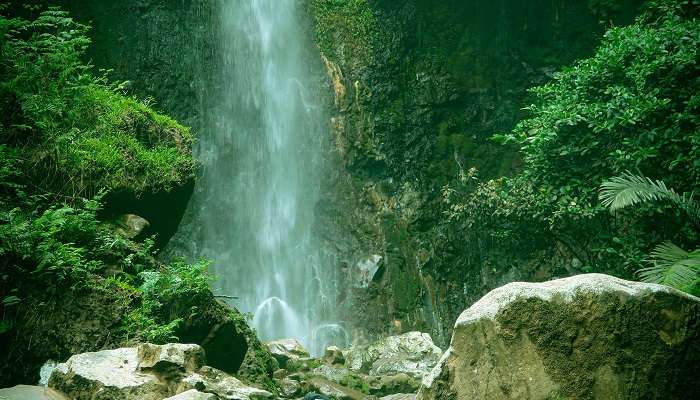Witness The Beauty Of Kulhi Katandi, Popularly Known As The Mini Thailand Of India

Mini Thailand, locally known as Kulhi Katandi or Veer Ki Aar, is a tourist spot in Jibhi in the Tirthan Valley of Himachal Pradesh. It is located within a dense forest of pine and deodar trees. It is a stream flowing through two huge rocks, which looks like a picture from Thailand, hence, the name. This treasure of nature must be viewed at least once in your life. Places like these make your vacations memorable. You can discover the beautiful scenery Jibhi has to offer and forget about all the frustrations and stresses of your city life.
Packing Essentials To Go To Kulhi Katandi

Kulhi Katandi is not accessible by public transport, a car, or even a bike. Everyone who wishes to visit must go on a trek to reach this magical valley. Located in Jibhi, which stands at an altitude of 6,200 feet from sea level, one cannot go unprepared.
A place usually isolated by commercial wolves is a promising site to see, but one must always be prepared for the unknown, especially if one is not used to the altitude and terrain of the rocky mountains of the Himalayas. Here is a list curated for all the essential items one might need for their trek.
- Medicines: A new environment might affect your body. You might have certain reactions, such as headaches, fever, motion sickness, cough, and cold, for which you must carry all the required medicines. If you suffer from any ailments such as diabetes, anxiety, insomnia, or any allergies, you must carry your prescribed medicines. It is always a safety precaution to meet with your doctor before going to a different environment where acclimatisation might be difficult.
- Clothes: The extreme weather conditions in the Himalayas require certain forms of protection. Double-check while packing that you have sweaters, caps, gloves, pants that are comfortable for hiking, shoes that do not give you any shoe bites, and woollen socks to keep you warm. Ensure you have enough clothes but not too many, as trekking might become difficult while carrying unnecessary weight.
- Gadgets: If you want to capture every moment of your trip or use your phone for navigation, then carrying all your essential gadgets is important. Just in case, make sure to carry your chargers and a battery bank. Buy new batteries for your camera before you leave on your trip and an extra one for emergencies.
- Eatables and Drinks: Trekking can be a physically taxing exercise, and those not used to hiking should be extra careful. Irrespective of whether you are a pro or a beginner, carrying small snacks like chocolates and dry fruits like almonds, cashews, and raisins is a good idea as they give you instant energy and do not need a lot of space in your bag.
- Body Care: At such a high altitude, UV rays can be more harmful than in low-altitude areas. To avoid chapped lips, carry a hydrating lip balm, sunscreen with SPF30 or higher, caps, wet wipes, hand sanitiser, and UV sunglasses to shield your eyes from bright sunlight.
- Bags: As the saying goes, ‘work smart, not hard’ should be applied when packing for a trek. Carry bags like a rucksack with an additional waist bag to comfortably carry all your essentials while walking for miles on the bumpy trekking trails.
Must Read: Places To Visit In Jibhi
Nearby Places You Must Visit Near Kulhi Katandi
Along with paying a memorable visit to Kulhi Katandi, many places also await your exploration. These are as follows:
1. Great Himalayan National Park

This park is one the most famous tourist attractions in Jibhi and not visiting this park will leave your trip incomplete. This park is 54 km away from Kulhi Katandi. It is home to over 100 plant species like juniper, alpine herbs, chestnut, pine, and even spruces. All the plants you see here are said to have medicinal value.
Due to its abundance of flora and fauna, tourists need permission to enter the park as great measures have been taken to protect the animal species in the park as it was a hub for poaching amongst tourists. The best time to visit the Great Himalayan National Park is March, April, May, June, and mid-September, October, and November.
2. The Raghupur Fort

There are a lot of speculations that Mandi rulers made this fort to protect themselves and their kingdom from invaders. However, its true purpose and use have been lost, just like most of this structure. Only a few pillars are left as evidence of this fort’s existence.
This ruined fort has a meadow too where tourists can camp during the summers. The journey to the fort is a rocky one at best. It is a 3 km trek which might be difficult as the path is covered with Himalayan greenery. There is a small lake within the premises of the fort.
Suggested Read: Waterfalls In Himachal Pradesh
3. Sunshine Himalayan Adventures

The SHA or The Sunshine Himalayan Adventures is an organization made of people with experience in venturing into wildlife, trekking, mountaineering, and many more fun activities. They have 21 years of experience in organizing treks and their work is not only limited to that. They have an ecotourism approach where they make conscious decisions to support and help locals and their businesses.
Their goal is to ensure not only an amazing trekking and tour experience for their guests but also to encourage them to learn about the cultures and way of life in several villages and towns in the Himalayas. They want people to enjoy their time and understand the importance of the mountains and their people.
4. Serolsar Lake

To visit this beautiful lake, you can drive down to Jalori Pass, which is 11 to 12 km away, and from there, you can trek to Serolsar Lake. This is an hour-and-a-half trek that is situated in Kullu. A wonderful trek surrounded by oak trees and fresh air is a great start to your journey. Tourists can camp here for one night and enjoy watching the stars on a clear night sky. At the bottom of the Jalori Pass is the Budha Nagini Temple which you can visit as you walk back.
Suggested Read: Barot Valley
5. Chhoei Waterfall

The name comes from the local Deity of the Nagini Village called Chhoi Mata. Locals and devotees come to the waterfall and pray to a particular tree in front of it to seek her blessings. It is situated in Tirthan Valley and is a 3 km walk from the village which approximately takes an hour to reach.
Now that you know better about this hidden treasure book a trip to Jibhi and explore India’s Mini Thailand with friends and family to have a blast. Kulhi Katandi is such as blissful place to plan a vacation with your loved ones and have a mesmerising holiday experience.
For our editorial codes of conduct and copyright disclaimer, please click here.
Cover Image Source: Phototraveller1 for Wikimedia Commons
Frequently Asked Questions About Kulhi Katandi
Is Kulhi Katandi have another name?
Kulhi Katandi is the name used by the locals which not a lot of people are familiar with. People might have heard the name ‘Mini Thailand’ as this is what tourists refer to it as.
How can you reach Kulhi Katandi?
Once you reach Jalori Pass you will have to trek for about 250-300 metres before taking a right and trek for another 200 metres and you shall reach the small pond with a stream flowing between two huge rocks.
Can you reach Jalori Pass via public transportation?
Yes, buses do travel to Jibhi from Delhi, Shimla, Manali and Chandigarh. You can also take a cab to reach Jalori Pass.
Is it necessary to hire a guide to reach Kulhi Katandi?
It is not necessary but it is advisable to hire a tour guide as you might get lost somewhere in the deep forests of Jibhi.
When is the best time to visit Kulhi Katandi?
Spring time, between March to June, is the best time to visit Kulhi Katandi as the snow melts and green valleys and forests are revealed offering a mesmerizing view.
People Also Read:
Kamlah Fort In Himachal Chindi In Himachal Jagatsukh In Himachal

Get ready to wander the world through amazing visual tours that we provide via our blogs and stories. As a content writer, I love sharing incredible travel experiences that inspire readers to plan their own adventures and create unforgettable memories. From planning to execution, everything has already been served in these amusing tales. Let’s explore the world together, one destination at a time!











